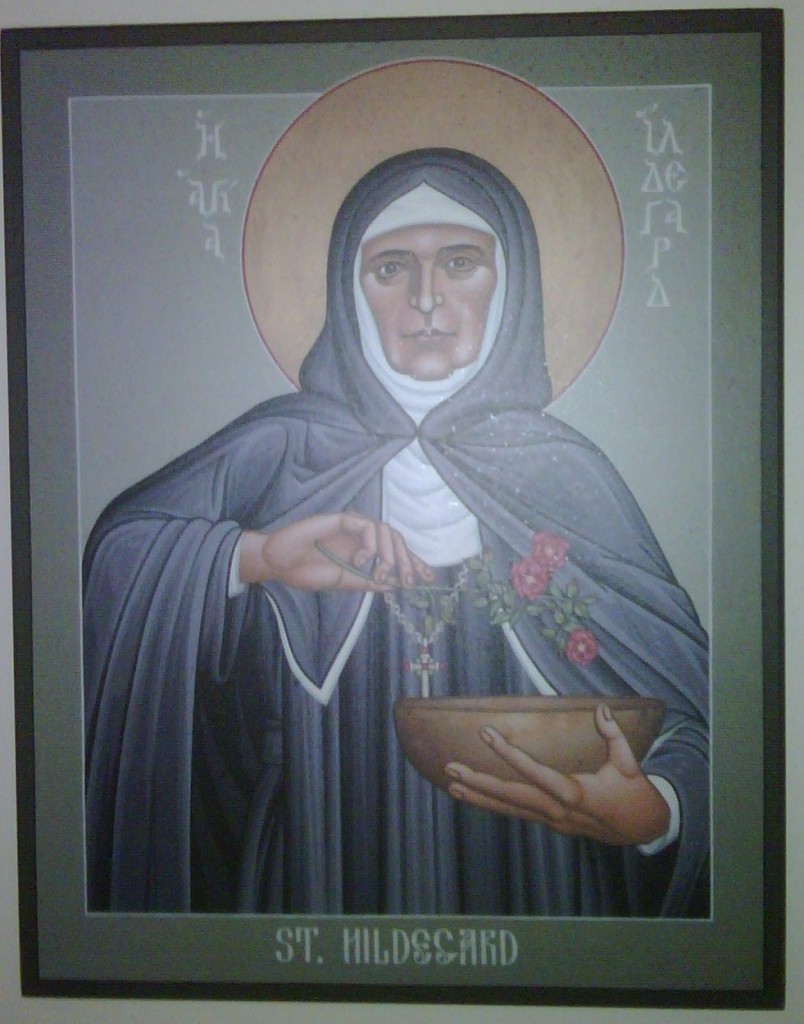During the season of Lent in my congregation, we are hearing from the “cloud of witnesses.” Each week we follow along with guides who are helping us through the season. We are listening both to contemporary and more ancient figures. Many of them have been granted sainthood, but not all. Hildegard is among those we are thinking with and listening to as a community while we journey through Lent.
Hildegard of Bingen became a favorite figure for me while I was still in seminary. I wrote about her for various curricula and found her poetry and images of the “greening power of God” to be evocative. She lived in the twelfth century and is considered a “polymath,” meaning she was expert at many things. For instance Hildegard had visions throughout her life (beginning by age three). She was an abbess, a poet, preacher, healer, scientist and gardener, playwright, theologian, musician and composer. She wrote her own alphabet, conversed with Bernard of Clairvaux and popes and magistrates. Still in existence are available “100 letters, 72 songs, 70 poems, and 9 books.”* In short, she was a renaissance woman way ahead of her times.
There is a lot more to say about Hildegard, but for now, we’ll let some of her music speak for itself. Her music falls into two main collections: what she wrote for singing in the Daily Office (prayers, scriptures and songs through each day in the Benedictine tradition) or as part of a cycle of songs in a musical drama entitled “Ordo Virtutum or The Ritual/Drama of the Virtues.” The drama was the first of its kind anywhere.
As one interpreter says, in writing about the significance of Hildegard’s music:
“She believed that many times a day, we fall out of sorts, lose our way or find ourselves off center. Music was the sacred technology which could best tune humanity, redirect our hearts toward heaven and put our feet back onto the wholesome pathways of God.”
You can listen to a recording of her music Here: O frondens virga (Antiphon for the Virgin). It is in praise of Mary.
Antiphon for the Virgin
O leafy branch, standing nobly
in the coming dawn:
now be glad and rejoice
and deign to free our frailty
from evil ways
and reach out your hand
to raise us up.
[Flanagan, 122 **]O frondens virga (in the Latin)
O frondens virga, in tua nobilitate stans
sicut aurora procedit:
nunc guade et letare
et nos debiles dignare
a mala consuetudine liberare
atque manum tuam porrige
ad erigendum nos.
- Fox, Matthew. Illuminations of Hildegard of Bingen (New Mexico: Bear and Company, 1985), 6
** Hildegard of Bingen. Secrets of God: Writings of Hildegard of Bingen (trans. and ed. by Sabina Flanagan). Boston: Shambhala Publications, 1996.
Reminder:
For Lent, my posts are a different kind of meditation. Instead of “giving something up” to help focus on prayer and renewal, I am focused on healing through taking up a new/old practice, which can considered a pop-culture version of visio divina – divine viewing. It is somewhat like lectio divina – divine reading – which may be more familiar. The latter is a slow purposeful reading of a brief text – usually Scripture. The newer visio divina grows out of lectio divina and is a conversation between scripture text and artistic text.




